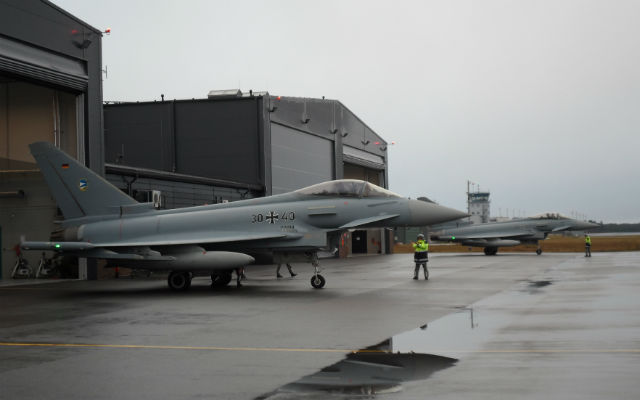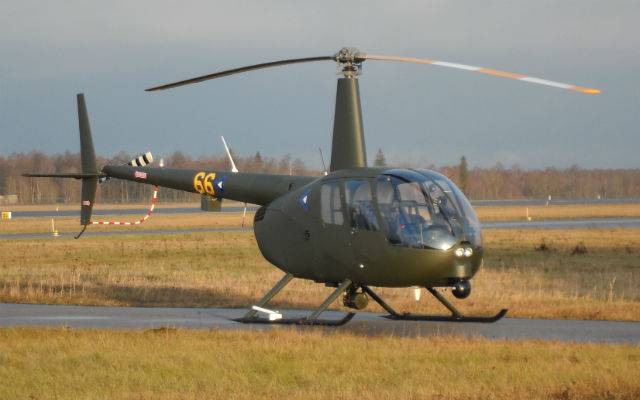The increased tensions in eastern Europe as a result of Russia’s advances into Ukraine resulted in NATO’s Baltic Air Policing (BAP) effort ramping up in May this year, including the establishment of a permanent detachment at Amari air base in Estonia.
Amari BAP operations were bolstered up to 24/7 readiness, and are now set to continue at this level until at least the end of 2015 as a series of full-time detachments are planned to provide quick reaction alert (QRA) capabilities in the region.
NATO has decided that a Eurofighter Typhoon capability will extend throughout 2015 for QRA operations from the Baltic state; currently a German air force Eurofighter deployment operates from the base, and will hand over to a Spanish air force detachment of the same aircraft type on 2 January.
The four-month Spanish Typhoon stationing will be followed by one from the UK, and then another from Germany, taking the BAP QRA capability at Amari up to the end of 2015 with “extensive Eurofighter operations”.
“We can’t deliver kinetic effects,” Col Jakk Tarien, commander of the Estonian air force, told media at Amari on 17 December. “What we do do is support allies that are delivering that effect on our behalf.”
The German air force was stationed with its Eurofighters – on its sixth BAP mission to date, although the first in Estonia – at Amari in September, since when it has carried out some 255 sorties, deploying on an average two flights per day from Monday to Friday.
The detachment includes four aircraft stationed at the base, with two further on a 96h standby in Germany. Typically two aircraft carry out each sortie, while two remain on standby at Amari.

Beth Stevenson/Flightglobal
The air policing effort is designed to provide air defence QRA cover to the three most eastern NATO states – Estonia, Latvia and Lithuania – which the alliance has been carrying out on a rotational basis since they joined NATO in 2004.
In light of the tensions between NATO and Russia that heightened in 2014 – the former has openly condemned the latter’s advances into Crimea and Ukraine – the BAP was ramped up to include all three detachments based in Estonia, at Siauliai air base in Lithuania and also in Poland conducting air policing missions at any given time.
The deployments that will end at the beginning of January are the second bolstered rotations, which include ensuring that Estonia now maintains a 24/7 readiness – something which was not expected to happen until mid-2015.
“It took a lot of work – it was not in our plan to increase to 24/7 readiness so soon,” Tarien says. “In our plan we had foreseen the 24/7 coverage beginning in 2015.”
Even then, Estonia expected to host 24/7 rotations that would intermittently be followed by recuperation periods, Tarien says, and is not expected to provide a non-stop coverage throughout the year.
“This will continue unless something drastic happens – in a positive sense – with the situation in Ukraine,” he adds.
The mission is split into two main areas, with Air Policing Area (APA) 1 controlled by the Combined Air Operation Centre (CAOC) Finderup in Denmark, and APA 2 – which covers the Baltic states – controlled from CAOC Uedem in Germany. These both feed into the NATO Allied Air Command in Ramstein, Germany.
Being the state that has an air base within the closest proximity to Kaliningrad – a Russian territory between Lithuania and Poland – Lithuania is best positioned to conduct missions that involve carrying out surveillance in that area, although the decision on which base will scramble to an area is decided by the Uedem CAOC.
Portuguese and Canadian air force personnel have been stationed at Siauliai for the past rotation, with Lockheed Martin F-16s and Boeing CF-18 Hornets respectively, while the Netherlands has been based out of Malbork air base in Poland with its F-16s.
The detachments engage in alternate “hot” and “cold” weeks. Both of these involve the full aircraft capability, but during cold weeks personnel numbers are not at full capacity, while during hot weeks they are.
“Alpha” missions are active sorties in response to activity in NATO airspace that needs assessing, while “tango” sorties are training missions. A tango sortie can be recategorised as an alpha in mid-flight if need be, and training missions are flown as operational ones, with weapons integrated.
NATO standards dictate that an alpha sortie deploys within 30min, but the German air force aims for 15min and often achieves it in 10min, it says.
Although both Estonia and Germany do not consider there to have necessarily been an increase in aggression from Russian aircraft in the region, there has certainly been an increase in the number of flights that skirt around and into NATO airspace, and in turn an increased alertness has been activated from the alliance.
By mid-December, the number of alpha missions that had to be carried out by the German air force that month significantly increased, with one week in particular featuring more than 10 operational alpha sorties. One such mission during that week required all four German Eurofighters to be deployed from Amari, which is a rare occurrence, the air force says.
“When we had exercises in June, we saw an increase in their [Russia’s] activity,” Tarien adds. “In an ideal world I’d like to see Russia act as a normal Western-like democracy so that there is no need for special defence measures, but I don’t see this happening any time in the next 10 years, so we need allied presence here long term.”
Sharing a border with Russia, Estonia is in a vulnerable position, and Tarien says that an increased NATO readiness provides comfort.
“We know NATO allies will defend us, but we don’t want this to materialise. We want to prevent it,” he says. “We feel most secure when there is a bolstered allied presence here.”
Most interceptions with Russian aircraft occur in the same location. Russia regularly takes a quick route over Estonian territorial waters, although the short time it takes for it to do this takes rarely results in a NATO BAP scramble.
"NATO's orders are extremely clear," Lt Col Gordon Schnitger, commander of the German detachment and a Typhoon pilot, adds. "We are supposed to be defensive, not offensive.
"We are only ID-ing the aircraft. Our aim is to be visible… We're here as a political statement."
Schnitger adds that a four-ship formation of varying aircraft is ideal so as to train against different aircraft types, so it is advantageous when the opportunity to fly with the Portuguese and Canadian aircraft arises.
Also based at Amari are four Robinson R44 helicopters, two Aero Vodochody L-39 trainers and two Antonov An-2 transports, although the latter are expected to be replaced with Short C-23 Sherpas in 2015.

Beth Stevenson/Flightglobal
The two Antonovs have been in service for 50 and 55 years, respectively, and although they are operational and provide transport and low-speed surveillance – they only fly at 90kt (166km/h) – they will be replaced with a newer, more capable aircraft.
For information exchange, Link 16 is not available, so the NATO BAP nations bring their own Link 16 capability to Amari. However, Tarien says that a domestic implementation of this for secure communications is high on the Estonian air force’s priority list.
The base has also held a number of multinational NATO exercises, and several are planned for 2015. US President Barack Obama visited Estonia in October, and claimed that the USA wanted to increase training in the country.
“We’re excited about this,” Tarien says. “Of course the integration details are pending, depending on US defence budgets.”
Amari also has an air surveillance wing that is operated in parallel to the flying wing.
Two ThalesRaytheonSystems GroundMaster 400 air defence radars, one of which has already been delivered, will provide the required air radar coverage for Estonia.
Russian military aircraft are renowned for not carrying transponders or for submitting flight plans, so using radar allows for NATO to keep track of Russian movements in the region.
Meanwhile, Hungary is expected to carry out its first BAP rotation in 2015, as will Italy, adding to the 14 member nations that have already contributed to the effort. In January, Italian Eurofighters will replace Portuguese F-16s, while Poland will deploy RAC MiG-29s to Siauliai.
Source: Flight International























